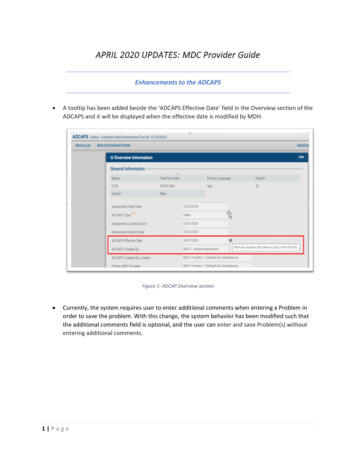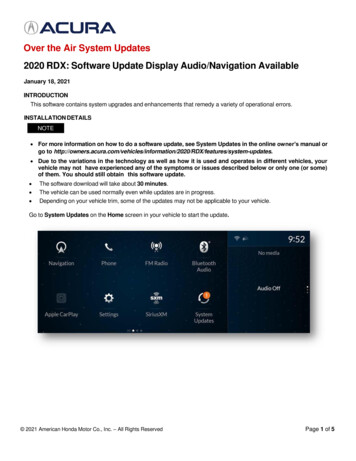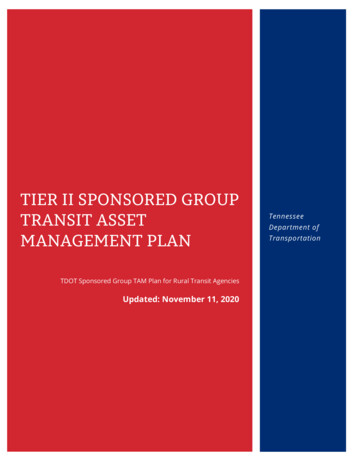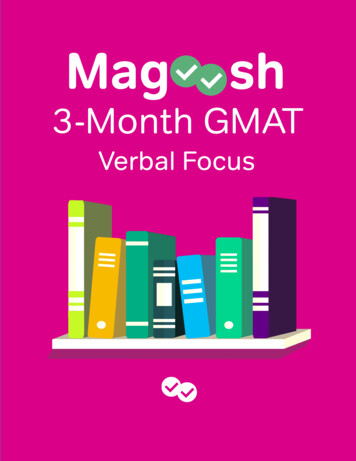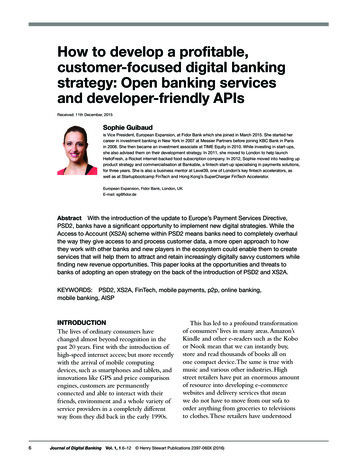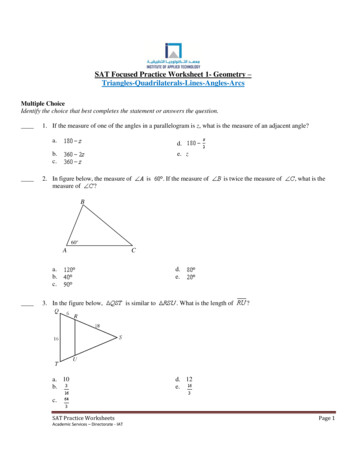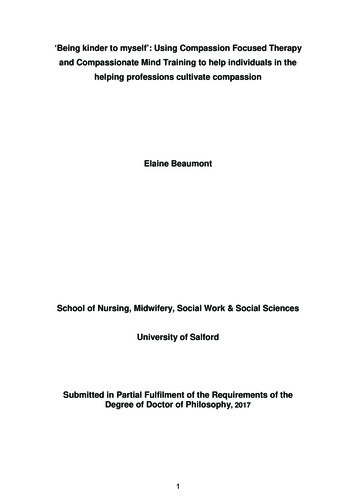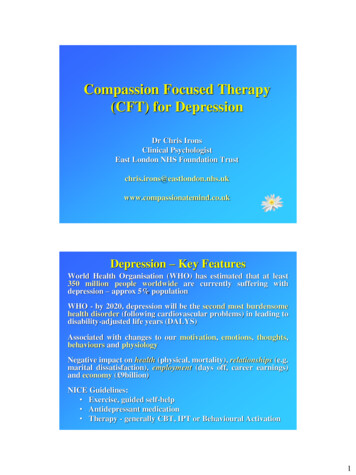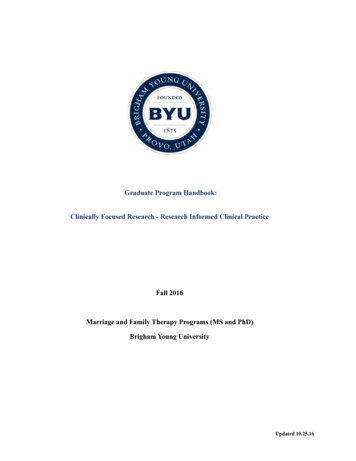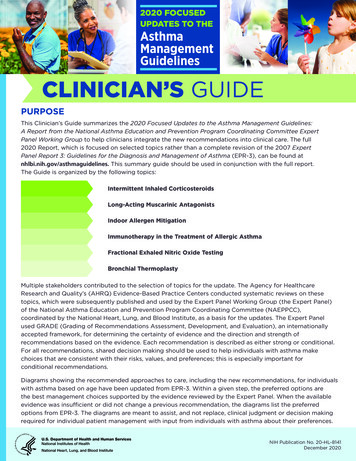
Transcription
2020 FOCUSEDUPDATES TO THEAsthmaManagementGuidelinesCLINICIAN’S GUIDEPURPOSEThis Clinician’s Guide summarizes the 2020 Focused Updates to the Asthma Management Guidelines:A Report from the National Asthma Education and Prevention Program Coordinating Committee ExpertPanel Working Group to help clinicians integrate the new recommendations into clinical care. The full2020 Report, which is focused on selected topics rather than a complete revision of the 2007 ExpertPanel Report 3: Guidelines for the Diagnosis and Management of Asthma (EPR-3), can be found atnhlbi.nih.gov/asthmaguidelines. This summary guide should be used in conjunction with the full report.The Guide is organized by the following topics:Intermittent Inhaled CorticosteroidsLong-Acting Muscarinic AntagonistsIndoor Allergen MitigationImmunotherapy in the Treatment of Allergic AsthmaFractional Exhaled Nitric Oxide TestingBronchial ThermoplastyMultiple stakeholders contributed to the selection of topics for the update. The Agency for HealthcareResearch and Quality’s (AHRQ) Evidence-Based Practice Centers conducted systematic reviews on thesetopics, which were subsequently published and used by the Expert Panel Working Group (the Expert Panel)of the National Asthma Education and Prevention Program Coordinating Committee (NAEPPCC),coordinated by the National Heart, Lung, and Blood Institute, as a basis for the updates. The Expert Panelused GRADE (Grading of Recommendations Assessment, Development, and Evaluation), an internationallyaccepted framework, for determining the certainty of evidence and the direction and strength ofrecommendations based on the evidence. Each recommendation is described as either strong or conditional.For all recommendations, shared decision making should be used to help individuals with asthma makechoices that are consistent with their risks, values, and preferences; this is especially important forconditional recommendations.Diagrams showing the recommended approaches to care, including the new recommendations, for individualswith asthma based on age have been updated from EPR-3. Within a given step, the preferred options arethe best management choices supported by the evidence reviewed by the Expert Panel. When the availableevidence was insufficient or did not change a previous recommendation, the diagrams list the preferredoptions from EPR-3. The diagrams are meant to assist, and not replace, clinical judgment or decision makingrequired for individual patient management with input from individuals with asthma about their preferences.NIH Publication No. 20-HL-8141December 2020
2020 FOCUSED UPDATES TO THEAsthma Management GuidelinesCLINICIAN’S GUIDEINTERMITTENT INHALEDCORTICOSTEROIDSScheduled, daily inhaled corticosteroid (ICS) treatment is thecurrently preferred pharmacologic controller therapy for persistentasthma in individuals of all ages. Intermittent ICS dosing includescourses of ICS treatment used for brief periods, usually in responseto symptoms or as an add-on with or without a long-actingbeta2-agonist (LABA). Recommendations for ICS treatment areorganized by age.Children Ages 0–4 Years with Recurrent WheezingKEY POINTRECOMMENDATIONIn children ages 0–4 years with recurrent wheezing, a short (7–10day) course of daily ICS with as-needed inhaled short-actingbeta2-agonist (SABA) for quick-relief therapy is recommendedstarting at the onset of a respiratory tract infection.In children ages 0–4 years withrecurrent wheezing triggeredby respiratory tract infectionsand no wheezing betweeninfections, the Expert Panelconditionally recommendsstarting a short course of dailyICS at the onset of a respiratorytract infection with as-neededSABA for quick-relief therapycompared to as-needed SABAfor quick-relief therapy only.IMPLEMENTATION GUIDANCE AND CONSIDERATIONS FORSHARED DECISION-MAKING Target population: Children ages 0–4 years with recurrentwheezing (at least three episodes of wheezing triggered byapparent infection in their lifetime or two episodes in the pastyear with no symptoms between infections) and who are nottaking daily asthma treatment. Treatment: One regimen used in two reviewed studies isbudesonide inhalation suspension, 1 mg twice daily for 7 days atthe first sign of respiratory tract infection-associated symptoms. Potential benefits: The main benefit during respiratory tractinfections is a reduction in exacerbations requiring systemiccorticosteroids. Potential risks: This treatment could affect growth. Carefullymonitor growth in children who use this treatment. Other considerations: Caregivers can initiate intermittent ICStreatment at home without a visit to a health care provider whenthey have clear instructions.2
2020 FOCUSED UPDATES TO THEAsthma Management GuidelinesCLINICIAN’S GUIDEIndividuals Ages 4 Years and Older withPersistent AsthmaRECOMMENDATIONS (AGES 4 ) In individuals ages 4 yearsand older with mild tomoderate persistent asthmawho are likely to be adherentto daily ICS treatment, theExpert Panel conditionallyrecommends against a shortterm increase in the ICS dosefor increased symptoms ordecreased peak flow. In individuals ages 4 yearsand older with moderate tosevere persistent asthma, theExpert Panel recommendsICS-formoterol in a singleinhaler used as both dailycontroller and reliever therapycompared to either a higherdose ICS as daily controllertherapy and SABA for quickrelief therapy or the samedose ICS-LABA as dailycontroller therapy and SABAfor quick-relief therapy.KEY POINTS For individuals with mild to moderate persistent asthma whoare taking daily ICS treatment (likely adherent with prescribeddaily ICS) as a controller, increasing the regular daily ICSdose for short periods is not recommended when symptomsincrease or peak flow decreases. For individuals with moderate to severe persistent asthmaalready taking low- or medium-dose ICS, the preferredtreatment is a single inhaler with ICS-formoterol (referred toas single maintenance and reliever therapy, or “SMART”) usedboth daily and as needed.Individuals Ages 12 Years and Older withPersistent AsthmaKEY POINTS For individuals with mild persistent asthma, either of thefollowing two treatments are recommended as part of Step 2therapy: 1) a daily low-dose ICS and as-needed SABA forquick-relief therapy, or 2) intermittent as-needed SABA and ICSused one after the other for worsening asthma.9One approach to intermittent therapy is 2–4 puffs ofalbuterol followed by 80–250 mcg of beclomethasoneequivalent every 4 hours as needed for asthma symptoms.9Intermittent therapy can be initiated at home with regularprovider follow-up to ensure that the intermittent regimenis still appropriate.9Individuals with either low or high perception of symptomsmay not be good candidates for as-needed ICS therapy.Daily low-dose ICS with as-needed SABA may be preferred.For individuals with moderate to severe persistent asthmaalready taking low- or medium-dose ICS, the preferredtreatment is a single inhaler with ICS-formoterol (referred toas single maintenance and reliever therapy, or “SMART”) usedboth daily and as needed.3RECOMMENDATIONS (AGES 12 ) In individuals ages 12 yearsand older with mild persistentasthma, the Expert Panelconditionally recommendseither daily low-dose ICSand as-needed SABA forquick-relief therapy or asneeded ICS and SABA usedconcomitantly. In individuals ages 12 yearsand older with moderate tosevere persistent asthma, theExpert Panel conditionallyrecommends ICS-formoterolin a single inhaler used asboth daily controller andreliever therapy comparedto higher-dose ICS-LABA asdaily controller therapy andSABA for quick-relief therapy.
2020 FOCUSED UPDATES TO THEAsthma Management GuidelinesCLINICIAN’S GUIDESINGLE MAINTENANCE AND RELIEVER THERAPY (SMART)IMPLEMENTATION GUIDANCE AND CONSIDERATIONS FORSHARED DECISION MAKING Target population: Individuals 4 years and older with a severeexacerbation in the prior year are particularly good candidatesfor SMART to reduce exacerbations. Who should not receive this treatment: Do not use ICSformoterol as reliever therapy in individuals taking ICSsalmeterol as maintenance therapy. Treatment: Inhaled ICS-formoterol in a single inhaler. This formof therapy has only been studied with formoterol as thelong-acting beta2-agonist (LABA).9SMART is appropriate for Step 3 (low-dose ICS) and Step 4 (medium-dose ICS) treatment.9Individuals whose asthma is uncontrolled on maintenance ICS-LABA with SABA as quick-relieftherapy should receive the preferred SMART if possible before moving to a higher step of therapy.9ICS-formoterol should be administered as maintenance therapy with 1–2 puffs once or twice daily(depending on age, asthma severity, and ICS dose in the ICS-formoterol preparation) and 1–2puffs as needed for asthma symptoms.9Maximum number of puffs per day is 8 (36 mcg formoterol) for children ages 4–11 years and 12(54 mcg formoterol) for individuals ages 12 years and older.9Advise individuals to contact their physician if they need to exceed maximum number of puffs.9Dose of formoterol was based on 4.5 mcg/inhalation, the most common preparation used in thestudies reviewed. Potential benefits: In studies this treatment consistently reduced asthma exacerbations requiringunscheduled medical visits or systemic corticosteroids and in some studies improved asthma controland quality of life. Reduced exposure to oral corticosteroids and to ICS treatment suggest that theintervention might reduce future corticosteroid-associated harms. Potential risks: Studies found no difference in documented harms between this type of therapy anddaily ICS, or ICS-LABA, with SABA as quick relief therapy. Other considerations:9In children ages 4–11 years, there may be a lower risk of growth suppression among those takingSMART versus daily higher-dose ICS treatment.9This recommendation might not be appropriate for some individuals with asthma because of cost,formulary considerations, or medication intolerance.9A 1-month supply of ICS-formoterol medication that is sufficient for maintenance therapy may notlast a month if the inhaler is used for reliever therapy as well.4
2020 FOCUSED UPDATES TO THEAsthma Management GuidelinesCLINICIAN’S GUIDELONG-ACTING MUSCARINIC ANTAGONISTSLong-acting muscarinic antagonists (LAMAs)* comprise apharmacologic class of long-acting bronchodilators.Individuals Ages 12 Years and Older withUncontrolled Persistent AsthmaKEY POINTS In individuals with asthma that is not controlled by ICStherapy alone, adding a LABA rather than a LAMA to anICS is recommended. However, if a LABA cannot be used (unable to tolerate,contraindication, inability to use device, or the LABAis unavailable), adding a LAMA to an ICS is anacceptable alternative. For individuals whose asthma is not controlled with ICS-LABA,adding a LAMA is recommended for many individuals becauseit offers a small potential benefit.RECOMMENDATIONSIMPLEMENTATION GUIDANCE AND CONSIDERATIONS FORSHARED DECISION MAKING When to use treatment: Prescribe this medication forlong-term asthma control in the ambulatory setting. Who should not receive this treatment: Individuals at risk ofurinary retention or those who have glaucoma. Potential benefits: The addition of a LAMA to ICS-LABA mayimprove asthma control and quality of life. The addition of aLAMA to an ICS provides a small potential benefit comparedto continuing the same ICS dose if an individual cannot use aLABA for any reason. Potential risks: Adding a LAMA to ICS controller therapyprovides no more benefit than adding a LABA to ICS controllertherapy and may increase the risk of harm, based on a singlereal-world study in Blacks. Other considerations: Adding LAMA therapy to ICS-LABArequires the use of an additional and different type ofinhaler. Teach individuals with asthma how to use thesedevices appropriately. In individuals ages 12 yearsand older with uncontrolledpersistent asthma, theExpert Panel conditionallyrecommends against addingLAMA to ICS compared toadding LABA to ICS. If LABA is not used inindividuals ages 12 yearsand older with uncontrolledpersistent asthma, theExpert Panel conditionallyrecommends adding LAMAto ICS controller therapycompared to continuing thesame dose of ICS alone. In individuals ages 12 yearsand older with uncontrolledpersistent asthma, theExpert Panel conditionallyrecommends adding LAMAto ICS-LABA compared tocontinuing the same dose ofICS-LABA.At the time of this writing, tiotropiumbromide (RESPIMAT ) was the onlyformulation of LAMA with U.S. Food andDrug Administration (FDA) approval forasthma treatment.*5
2020 FOCUSED UPDATES TO THEAsthma Management GuidelinesCLINICIAN’S GUIDEINDOOR ALLERGEN MITIGATIONRECOMMENDATIONSIn some individuals, asthma can have an allergic component.Allergen mitigation strategies (e.g., air purifiers, impermeable pillowand mattress covers, HEPA filters) aim to decrease an individual’sexposure to allergens. In individuals with asthmawho have symptomsrelated to exposure toidentified indoor allergens,confirmed by history takingor allergy testing, theExpert Panel conditionallyrecommends a multicomponent allergen-specificmitigation intervention. In individuals with asthmawho have sensitizationor symptoms related toexposure to dust mites, theExpert Panel conditionallyrecommends impermeablepillow/mattress covers onlyas part of a multicomponentallergen mitigationintervention, not as a singlecomponent intervention. In individuals with asthmawho have sensitizationor symptoms relatedto exposure to pests(cockroaches and rodents),the Expert Panelconditionally recommendsthe use of integrated pestmanagement alone, or aspart of a multicomponentallergen-specificmitigation intervention. In individuals withasthma who do not havesensitization to specificindoor allergens orwho do not have symptomsrelated to exposure tospecific indoor allergens,the Expert Panelconditionally recommendsagainst allergenmitigation interventionsas part of routineasthma management.KEY POINTS Overall, the studies revi
with asthma based on age have been updated from EPR-3. Within a given step, the preferred options are the best management choices supported by the evidence reviewed by the Expert Panel. When the available evidence was insufficient or did not change a previous recommendation, the diagrams list the preferred options from EPR-3. The diagrams are meant to assist, and not replace, clinical
